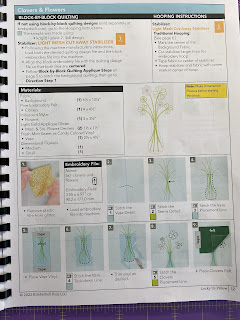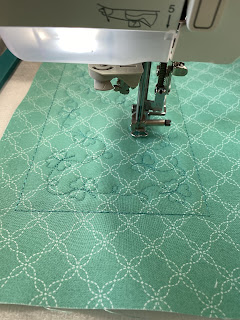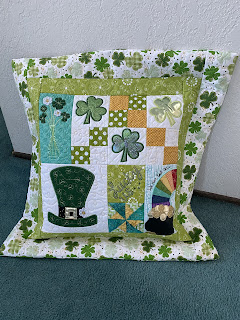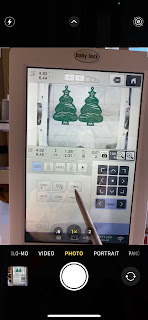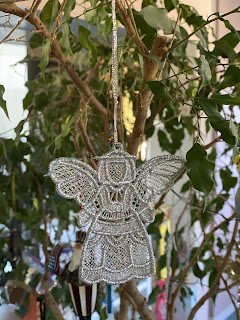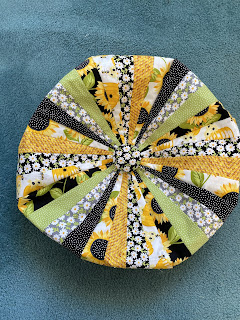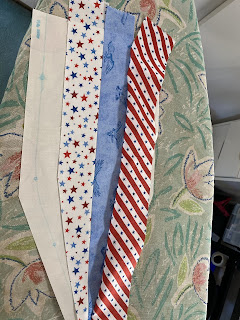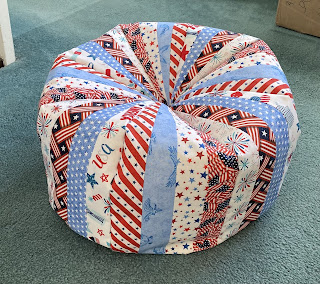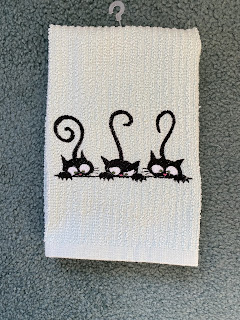Last summer I stumbled across a company called Kimberbell.
What caught my eye whilst browsing their website is their vast back catalog of machine embroidery projects they have available to choose from. I have to confess I have quite a few cute projects I want to do and they are all now waiting in the wings…
First up ‘Lucky Us’, this is a quilted pillow case, using the block-by-block method, completing each block “in the hoop” including the background quilting.
This design is available from Kimberbell’s website, under digital downloads, here is a link https://kimberbell.com/product/lucky-us-pillow/
Once downloaded, I save the files received into a folder onto my laptop, from there I print out the instructions. I think it’s good to read through the instructions and familiarize oneself with Kimberbell’s way of doing things. I attach a sample below.
Once you think you know what you are doing then you could just use an iPad or laptop to flick through the instructions. Having a printed copy also means you can write up any notes you might want reminding of, as you complete each block. I have started to bind mine, as the instructions for this pillow, were some 40 pages long.
Kimberbell’s instructions are pretty straight forward, once you are used to the way they explain their processes.
Save the embroidery files to a USB stick so they can be accessed over on your sewing machine. I find I save everything onto my computer under a folder called Kimberbell and then create lots of sub-folders which I save everything I have, also make sure you do backups regularly and then from there I save just the PES files onto my USB stick, I have a combo Brother sewing and embroidery machine. I sometimes have to rename files on my laptop otherwise it’s difficult to see what the file is on my sewing machine as it only displays the first 8 characters of the named file. You have to figure out a system that works for you.
I had a fabric kit cut for me. I use Kim’s Korner to cut mine and also order other Kimberbell products from. You can connect with Kim through her website - link below.
https://kims-korner.square.site/
You can cut your fabric from your own stash but a kit really helps if you are a newbie to Kimberbell. Something I learned watching some of the tutorials on YouTube is to look at the fabric cut instructions and look at the largest pieces in your kit and try to marry them up which fabric goes with it. Usually your kit will closely resemble that which Kimberbell uses in their sample pillow and if the fabric shop doesn’t have the exact fabric they’ll usually substitute it out for something that closely resembles it. One of the recommendations is to cut all your fabrics and place them into labeled bags as to which block they relate to. Also iron SF101 to the back of each piece of fabric, this really helps prevent the fabric puckering - you might want to do this before cutting your fabrics as it’s easier to iron on to larger pieces. You can order SF101 from Jo-Anns - I attach a link.
https://www.joann.com/pellon-sf101-shape-flex-fusible-interfacing-20x10-yds/13188750.html
You will also need to get the recommended stabilizers and project batting from Kimberbell or supplied through your Local Quilt Shop “LQS”. If you don’t have a LQS who can assist, you can order these items through Kim’s Korner, link above. If you already have a stabilizer that closely matches the one required, then by all means use what you have. Everything required will be listed at the beginning of the instructions for that item. Kimberbell seems to follow the same layout for each project which makes the next one a little easier to understand, once you’ve got to grips with what you are doing.
I also watched video tutorials for this pillow. I attach links below, in case you’re interested.
The above link is to Kimberbell’s video tutorials and below is of another lady Cristin Sohm of Cristin Creates, I follow her on YouTube and Facebook as she really breaks down the process to building your pillow or quilt.
These really really helped me. I strongly recommend watching each video through at least once before starting on your blocks. Each has their own style of teaching. Second time around you can then pause, play, go back and forth over the video as many times as you need.
Here are some photos from various Lucky Us blocks I put together…


